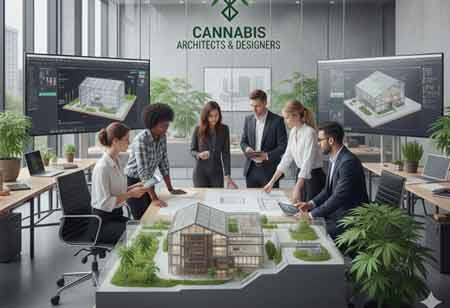Thank you for Subscribing to Cannabis Business Insights Weekly Brief
The Architectural Normalization of Cannabis Cultivation
The transformation of cannabis cultivation architecture is moving from concealed spaces to integrated, sophisticated designs that blend with urban and rural environments while prioritizing sustainability and community engagement.

By
Cannabis Business Insights | Wednesday, November 19, 2025
Stay ahead of the industry with exclusive feature stories on the top companies, expert insights and the latest news delivered straight to your inbox. Subscribe today.
The physical footprint of the cannabis industry is undergoing a profound metamorphosis. For decades, cultivation was defined by invisibility—relegated to windowless warehouses, subterranean basements, and nondescript industrial parks designed solely for concealment. However, as the industry matures and moves toward widespread legitimacy, the architectural language of cannabis is shifting from secrecy to sophistication. Today, cultivation facilities are no longer hidden; they are being designed as integrated components of the built environment, blending seamlessly into dense urban cores and sprawling rural pastoral landscapes alike.
This shift represents a new era of "architectural normalization." Design professionals are now tasked with creating high-performance facilities that respect local vernaculars, utilize advanced building technologies, and contribute positively to their communities' visual fabric.
Adaptive Reuse and Vertical Integration
In metropolitan environments, contemporary architectural strategies emphasize density and meaningful engagement with the surrounding urban fabric, marking a shift away from opaque, self-contained warehouse models. Adaptive reuse has become a defining approach, with architects transforming former industrial facilities—such as textile mills, printing plants, and automotive factories—into highly engineered, modern operations while preserving their historic structural envelopes. This approach maintains the established rhythm of the streetscape and reinforces an industrial chic aesthetic that aligns with the character of revitalizing districts. Exterior features such as long-sealed windows are being reopened, supported by innovations like smart glass and strategically planned interior circulation to balance stringent cultivation light requirements with the benefits of natural daylight in administrative and processing zones.
In parallel, the constraints of limited urban footprints have driven a rise in vertical cultivation facilities, creating a new architectural typology that leverages height rather than sprawl. These structures resemble mid-rise office buildings or data centers, and their design solutions prioritize integrating substantial mechanical systems—particularly HVAC and lighting—without disrupting the building’s external profile. Mechanical penthouses, louvered façades, and other concealed infrastructure systems support a streamlined appearance, allowing these facilities to blend seamlessly into technology parks and logistics districts while maintaining robust security and operational functionality.
Rural Harmonization: The Neo-Agrarian Aesthetic
Outside urban boundaries, the design approach shifts from containment to thoughtful integration with the rural environment. In these settings, the objective is to reconcile advanced pharmaceutical-grade production with the visual language of traditional agriculture. This evolution is most evident in the emergence of contemporary greenhouse architecture, where distinctive jagged rooflines and high-performance glazing systems replace older, utilitarian structures. Modern facilities are carefully aligned with natural topography, employing lowered foundations and ridge orientations that complement surrounding landforms. The resulting aesthetic is increasingly “Neo-Agrarian,” characterized by materials such as corten steel, treated timber, and stone—elements that weather naturally and visually anchor the facilities within the landscape. From afar, these hybrid structures evoke the familiar silhouettes of barns or stables, while up close they function as controlled, laboratory-grade environments.
Landscape architecture plays an equally critical role in ensuring visual continuity. Instead of relying on conventional fencing and paved perimeters, developers are incorporating berms, bioswales, and native planting buffers to soften structural edges and blend facilities into their agricultural surroundings. Security elements are discreetly embedded within these landscape features, preserving the area's pastoral character while meeting operational requirements.
A significant architectural development is the move toward transparency. Just as breweries and open-concept kitchens invite consumers to view the production process, select cannabis facilities are incorporating public-facing architectural elements.
In jurisdictions where it is permitted, architects are designing "hybrid" facilities that combine cultivation with retail or education. This requires a complex interior layout that separates secure, sterile grow zones from public spaces using high-security glazing. Visually, this allows visitors to see the "art" of cultivation—the rows of plants, the LED arrays, and the automated systems—turning the industrial process into a visual centerpiece.
This transparency serves a dual purpose: it creates an immersive brand experience and acts as a powerful architectural statement of legitimacy. It signals that the facility has nothing to hide, normalizing the plant's presence in the commercial sphere.
Olfactory Architecture and Invisible Systems
While visual integration is paramount, "olfactory architecture" is a critical, albeit invisible, component of modern facility design. To blend into a community, a facility must be undetectable to the nose.
Architectural integration now involves seamlessly embedding advanced air filtration systems. Exhaust stacks, once unsightly industrial appendages, are now architecturally shrouded or integrated into the building's massing. The "lungs" of the building are designed to be silent and scentless. By prioritizing the containment of terpenes within the building envelope through hermetic sealing and negative-pressure zones, architects ensure the facility is a good neighbor. This invisible engineering enables cultivation sites to be located closer to residential and commercial zones without sensory intrusion.
Sustainability has become a defining pillar of contemporary architectural integration, with the energy and resource demands of indoor cultivation directly shaping both form and materiality. Photovoltaic systems are now incorporated into rooflines and solar carports as intentional design elements that demonstrate a clear commitment to renewable energy. Roof structures are being optimized for rainwater recapture, and the associated storage silos are often expressed as deliberate architectural features rather than concealed utilities. In parallel, exterior façades increasingly incorporate living walls or vertical gardens that reinforce the biological essence of the operation, enhance insulation performance, and visibly connect the facility to its agricultural foundation.
Ultimately, the architecture chronicled here is creating a new commercial typology. The contemporary cannabis facility is evolving into a hybrid model: part high-tech laboratory, part agricultural showpiece, and part responsibly-designed neighbor. This architectural acceptance is crucial, as it fundamentally alters public perception, solidifying cannabis cultivation's place not as a clandestine operation, but as a normalized, value-adding component of the modern urban and rural landscape.






